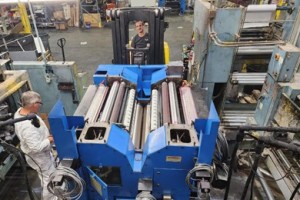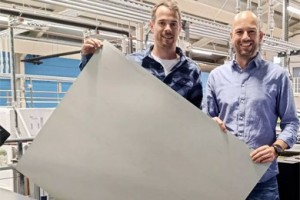
To see the difference the hybrid manroland press made, take a look in the mailroom. Peter Coleman revisits APN Yandina
A robotised log-stacker – the latest acquisition at APN Print’s Yandina, Queensland, site – is symbolic of the transformation semicommercial capacity can bring to a newspaper printer.
Relocated from a group site in New Zealand, the automated Müller Martini machine complements a mailroom which includes buffering, high-speed inserters, rotary trimmers and a saddlestitching line.
There’s a stark contrast between the busy hybrid site with its heatset manroland Uniset (single-width) and four-tower coldset Regioman (double-width) presses, and the heavily-burdened coldset-only line which preceded it.
The 2006 plant was the jewel in an Australian re-equipment programme which included new print sites at Bundaberg, Rockhampton, Toowoomba and Ballina equipped with Manugraph presses, and an upgrade in Mackay. This has been followed with a move of the Warwick sheetfed site to new premises, where an A1 press will be up and running by May.
Yandina’s hybrid capacity was commissioned primarily to deliver glossy sections to the 14 daily and 75 non-daily publications in APN’s Australian newspapers group, and despite the advertising downturn, the heatset section is running around the clock and nearing capacity.
 A bonus – and the reason for the log stacker – is a contract to print some of ACP’s specialist magazines including ‘Unique Cars’ and ‘Deals on Wheels’. Heatset sections for these and other perfect-bound titles go to a trade binder in Brisbane, where they are combined with coldset sections from Ballina and sheetfed covers printed in Warwick, while saddle-stitched titles are finished in Yandina.
A bonus – and the reason for the log stacker – is a contract to print some of ACP’s specialist magazines including ‘Unique Cars’ and ‘Deals on Wheels’. Heatset sections for these and other perfect-bound titles go to a trade binder in Brisbane, where they are combined with coldset sections from Ballina and sheetfed covers printed in Warwick, while saddle-stitched titles are finished in Yandina.“The market had been pretty buoyant when the plant started up, but petered out with the global financial crisis,” says general manager Greg Carson. “But with ACP and other external work, we’ve been able to extend production into weekends.
“We’re near to capacity on heatset, although there is room for growth on coldset.”
By weight, heatset accounts for about 30 tonnes of the 300 tonnes weekly production, with a similar amount of combined heatset/coldset work.
Of the 125 print runs in a typical week, about a dozen will be hybrid: Eight heatset pages – which must be produced straight – can included with up to 64 coldset pages from the Regioman, and can be split to appear at the centre and outside. In the week before my visit, the mix had included seven internal and four external jobs.
Carson says that while the process involves set-up time, this is also true of quarterfold work and jobs requiring non-standard web widths.
Stocks include 60 gsm Norske Skog (80 brightness), and 54, 65, 75 and 80gsm coated grades, much of which comes from Japan, while newsprint comes from Norske Skog and Apex (Oceanic Paper). Newsprint rolls are a giant 1270 mm in diameter – good for more than 20,000 copies – but coated stocks will typically be supplied on smaller rolls.
The single-width Uniset tower runs at up to 60,000 cph, but sometimes it seems enough heatset capacity is never enough: The all-glossy Saturday property section of the local ‘Sunshine Coast Daily’ – for which the run is 45,000 copies – calls for six 16-page sections, as well as another stitched 16-page supplement for an individual real estate agent inserted within it. These are stitched offline, and the bumper weekend edition will also require two coldset preprints and commercial inserts, as well as the main book.
It’s here that the highly mechanised mailroom comes into its own: The two folders are online to a six-station Müller Martini Printroll wind/unwind buffer with an Exacto rotary trimmer and two SLS3000 inserters (one of which had previously been installed at Maroochydore) downstream. Each SLS can take two products from buffer rolls, plus stream and hand-fed products.
The Vivo log stacker produces bundles up to 1.2 metres high, and those for further onsite processing are turned upright to make hopper loading on the offline Bravo saddlestitcher easier.
In the pressroom, space has been left for additional Regioman and Uniset towers, a second dryer... and even a complete second pressline if required.
With a team of 26 printers on rotating 12-hour shifts and in spite of the still-troubled economic situation, it’s a ordered and efficient operation which has helped to changed the marketing proposition for Australia’s third-largest newspaper publisher.















Comments